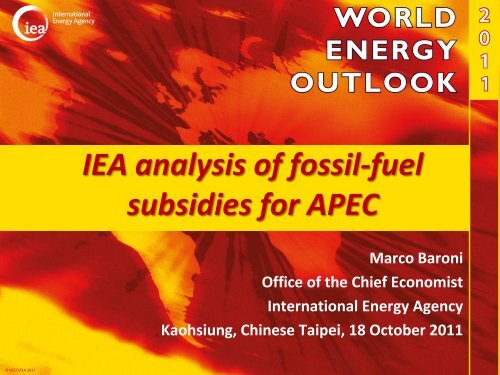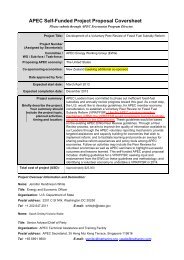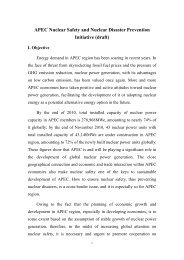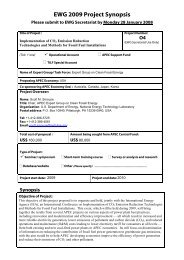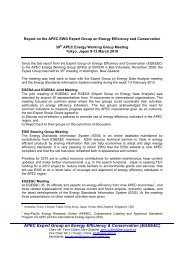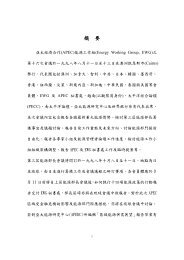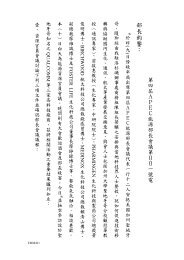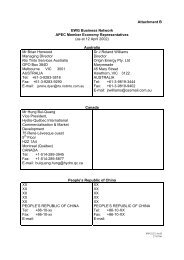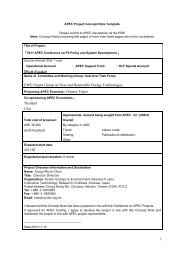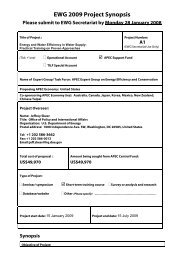IEA analysis of fossil-fuel subsidies for APEC
IEA analysis of fossil-fuel subsidies for APEC
IEA analysis of fossil-fuel subsidies for APEC
- No tags were found...
Create successful ePaper yourself
Turn your PDF publications into a flip-book with our unique Google optimized e-Paper software.
MtoePolicies could dramatically alterthe long-term energy outlookWorld primary energy demand by scenario20 00018 00016 00014 000Current Policies ScenarioNew Policies Scenario450 Scenario12 00010 0008 0006 0001980 1990 2000 2010 2020 2030 2035Compared with the New Policies Scenario, energy demand in 2035 is8% higher in the Current Policies Scenario and 11% lower in the 450 Scenario© OECD/<strong>IEA</strong> 2011
MtoePrimary energy demand in <strong>APEC</strong> economiesin the Current Policies Scenario12 00010 0008 0006 0004 000Other renewablesHydroNuclearGasOilCoal2 00001990 2000 2010 2020 2030 2035<strong>APEC</strong> energy demand expands by 44% between now and 2035 – an average rate <strong>of</strong>increase <strong>of</strong> 1.4% per year – with <strong>fossil</strong> <strong>fuel</strong>s remaining dominant in the energy mix© OECD/<strong>IEA</strong> 2011
160 L.R. Skelly et al. / Schizophrenia Research 98 (2008) 157–162through the posterior limb <strong>of</strong> the internal capsule (PLIC)and into the corona radiata <strong>of</strong> the cerebral hemispheres,bilaterally but stronger on the left. Lower FA was seen inassociation fibers in the cingulum (bilaterally in themedial temporal area and in right frontal portions), intemporal portions <strong>of</strong> the left inferior longitudinal fasciculus,and in the left anterior thalamic radiation. Commissuralfibers were significantly different in the <strong>for</strong>cepsminor <strong>of</strong> the frontal lobe. There was also a large, highlysignificant difference between groups in the right inferiorfronto-occipito fasciculus.3.2. Correlation/regression <strong>analysis</strong>In the correlation/regression <strong>analysis</strong>, negative correlations<strong>of</strong> FAvalues with PANSS positive symptom scoreswere seen in the left uncinate fasciculus, right sagittalstratum, and the left superior longitudinal fasciculus (seeFig. 2). Positive correlations with PANSS negativesymptom scores were found in one small area near theright insula, but in a different fiber tract than that reportedby Shin et al. (2006). There were no significant results inthe positive correlation with positive scores, the negativecorrelation with negative scores, nor was there significantcorrelation with PANSS general scores in either direction.4. DiscussionWe report diffuse differences in white matterintegrity between schizophrenia patients and matchedhealthy controls. Using robust normalization methodsand carefully matching results to specific white mattertracts, our findings both support disconnection hypothesis-basedexpectations in association and callosal fibersand detect unanticipated deficits in projection fibers.Projection fibers are not typically the target <strong>of</strong> whitematter studies <strong>of</strong> schizophrenia, but in their review <strong>of</strong>white matter lesion-induced deficits, Aralasmak et al.(2006) report that PLIC lesions have been variouslyassociated with apathy, impaired consciousness andverbal memory loss. We attempted to properly attributeobserved differences to the white matter tracts in whichthey were found and not to adjacent gray matterstructures or areas, which in certain cases (especiallyin the region <strong>of</strong> the basal ganglia/internal capsule) canbe potentially misleading. In the area <strong>of</strong> inferior fronto-Fig. 2. Negative correlation between PANSS p-score and FA values <strong>for</strong> 23 schizophrenia patients, masked at FA cut<strong>of</strong>f 0.18, pb0.01. Tracts whichreached a significant negative correlation are labeled by letter: A. uncinate fasciculus; B. sagittal stratum; C. superior longitudinal fasciculus.
Billion dollarsIranSaudi ArabiaRussiaIndiaChinaEgyptVenezuelaUAEIndonesiaUzbekistanIraqAlgeriaMexicoThailandUkraineKuwaitPakistanArgentinaMalaysiaBangladeshTurkmenistanKazakhstanLibyaQatarEcuadorFossil-<strong>fuel</strong> consumption <strong>subsidies</strong><strong>for</strong> top twenty-five countries, 20109080706050403020100ElectricityCoalNatural gasOilOil products had the largest <strong>subsidies</strong> at $193 billion, followed by natural gas at $91 billion,while <strong>fossil</strong>-<strong>fuel</strong> <strong>subsidies</strong> resulting from the under-pricing <strong>of</strong> electricity reached $122 billion© OECD/<strong>IEA</strong> 2011
Fossil-<strong>fuel</strong> <strong>subsidies</strong> can haveunintended effectsFossil-<strong>fuel</strong> <strong>subsidies</strong> result in an economically inefficient allocation <strong>of</strong> resources and marketdistortions, while <strong>of</strong>ten failing to meet their intended objectives© OECD/<strong>IEA</strong> 2011
Quantifying <strong>fossil</strong>-<strong>fuel</strong> consumption<strong>subsidies</strong> using the price-gap approach• A price-gap is the amount that an end-use price is below the full cost <strong>of</strong>supply or reference price• It is applicable where end-use prices are regulated and fall short <strong>of</strong>international market levels© OECD/<strong>IEA</strong> 2011‣ Does not capture: production <strong>subsidies</strong>, rebates to consumers, the effect <strong>of</strong>cross-<strong>subsidies</strong>, cost <strong>of</strong> investing in new capacity (electricity)• What costs are represented by estimates from the price-gap approach?‣ For net exporters, these are essentially opportunity costs‣ For net importers, these are estimates <strong>of</strong> direct, budgetary transfers• Relevant calculations‣ Subsidy = (reference price – end-use price) * consumption‣ Reference price (<strong>fuel</strong>s) = int’l price (quality adj) +/- freight & insurance + localdistribution + VAT‣ Reference price <strong>for</strong> electricity is based on annual average-cost pricing: calculatedfrom a weighted average <strong>of</strong> the cost <strong>of</strong> electricity production (according to specificpower mix), plus transmission and distribution
Quantifying <strong>fossil</strong>-<strong>fuel</strong> consumption<strong>subsidies</strong> using the price-gap approachLPGDieselInternational priceFreight and insuranceInternal distributionValue-added taxEnd-use pricePrice gap(subsidy)Gasoline0 0.2 0.4 0.6 0.8 1.0Dollars per litreThe price-gap method compares end-use prices paid by consumers with reference prices thatcorrespond to the full cost <strong>of</strong> supply – a subsidy is present if the end-use price falls short <strong>of</strong>the reference price© OECD/<strong>IEA</strong> 2011
Calculating electricity reference pricesInputReference PriceAnnual Avg.Fuel EfficiencyMix <strong>of</strong> PowerGenerationAvg. Cost <strong>of</strong> Generation is capped byLevelized Cost <strong>of</strong> a new CCGTOil$/unit38%26%New CCGTGasCoal$/unit$/unit45%36%43%10%Avg. Cost <strong>of</strong>GenerationReferencePriceNuclear/Renewables21%T&D andother costsThe electricity reference price takes into account the cost <strong>of</strong> generation from <strong>fossil</strong> <strong>fuel</strong>s,capped at the cost <strong>of</strong> a new gas CCGT plant© OECD/<strong>IEA</strong> 2011
What data is needed <strong>for</strong> countries tomake their own measurement?• End-use prices• To calculate reference prices:‣ International market (spot) prices‣ Shipping freight and insurance costs‣ Cost <strong>of</strong> local distribution‣ Rate <strong>of</strong> value-added tax• Total final energy consumption• Country imports and exports• Data should be collected and applied at the same level <strong>of</strong> detail‣ Consider sector/use, <strong>fuel</strong> grade, time period and region© OECD/<strong>IEA</strong> 2011
Methodology <strong>for</strong> modeling<strong>fossil</strong>-<strong>fuel</strong> and CO 2 savings• Calculate initial subsidisation rate (by <strong>fuel</strong>/use)• Choose time period over which to model subsidy phase-out• Decrease the subsidisation rate over the chosen period, raisingend-use prices• Fuel savings are linked to pace <strong>of</strong> change in end-use prices andthe elasticity <strong>of</strong> demand• CO 2 savings are calculated by applying emissions factors to <strong>fuel</strong>savings© OECD/<strong>IEA</strong> 2011
Billion dollarsDollars per barrelFossil-<strong>fuel</strong> consumption <strong>subsidies</strong> remain bigWorld <strong>subsidies</strong> to <strong>fossil</strong>-<strong>fuel</strong> consumption using the price-gap approach600150Rest <strong>of</strong> world500400300200100125100755025<strong>APEC</strong>economies<strong>IEA</strong> averagecrude oilimport price(right axis)02007 2008 2009 20100Worldwide, <strong>fossil</strong>-<strong>fuel</strong> consumption <strong>subsidies</strong> totaled $409 billion in 2010 – about $100 billionhigher than in 2009; among <strong>APEC</strong> economies, we estimate they reached $105 billion© OECD/<strong>IEA</strong> 2011
Subsidies per capita (dollars per capita)Subsidies per capita (dollars per capita)Fossil-<strong>fuel</strong> consumption <strong>subsidies</strong> percapita and as a percentage <strong>of</strong> total GDPCountries with higher ratesCountries with lower rates3 0003002 500QatarKuwaitUAEScale (billion $)40250RussiaKazakhstanMalaysia2 000Saudi Arabia102001 500150ArgentinaThailand1 0005000BruneiLibyaEcuadorPakistanSee belowVenezuelaTurkmenistanAlgeriaIranIraqEgypt0% 5% 10% 15% 20% 25%Subsidies as a share <strong>of</strong> GDP (MER)100500ChinaMexicoChineseTaipeiSouth AfricaPhilippinesNigeriaAzerbaijanIndiaIndonesiaVietnam<strong>APEC</strong>Other0% 1% 2% 3% 4%Subsidies as a share <strong>of</strong> GDP (MER)© OECD/<strong>IEA</strong> 2011The economic cost <strong>of</strong> <strong>subsidies</strong> can be more completely understood when viewed as apercentage <strong>of</strong> GDP or on a per-capita basis
Billion dollarsMajor energy producers are amongthe biggest subsidisersFossil-<strong>fuel</strong> consumption <strong>subsidies</strong> by net importer and net exporter <strong>of</strong> oil and natural gasin <strong>APEC</strong> economies120Exporter100Importer8060402002007 2008 2009 2010© OECD/<strong>IEA</strong> 2011For net exporters <strong>of</strong> oil and gas in <strong>APEC</strong> economies, <strong>subsidies</strong> to those <strong>fuel</strong>s totalled $74billion in 2010, compared with $31 billion in net-importing countries
Fossil-energy <strong>subsidies</strong> go mostly to the richShare <strong>of</strong> <strong>fossil</strong>-<strong>fuel</strong> <strong>subsidies</strong> received by the lowest income quintile by <strong>fuel</strong> in surveyedcountries*, 2010© OECD/<strong>IEA</strong> 2011Only 8% <strong>of</strong> the amount spent on <strong>fossil</strong>-<strong>fuel</strong> consumption <strong>subsidies</strong> in 2010, reached thepoorest 20% <strong>of</strong> the population
Recent pricing re<strong>for</strong>ms in selected countriesCountryAngolaIndiaIndonesiaIranJordanMalaysiaDescription <strong>of</strong> actions or announced plansRaised gasoline & diesel prices by 50% and 38% in Sept 2010. Plans to reduce <strong>fuel</strong> <strong>subsidies</strong> by 20% per year until eliminated.Scrapped regulation <strong>of</strong> gasoline prices in June 2010, with plans to do the same <strong>for</strong> diesel; Plans to eliminate cooking gas andkerosene <strong>subsidies</strong> in a phased manner starting April 2012, replacing with direct cash support to the poor.Postponed a restriction <strong>of</strong> subsidised <strong>fuel</strong> <strong>for</strong> private cars in February 2011, which could push state <strong>subsidies</strong> higher than thebudgeted amount. Previous plansSignificantly cut energy <strong>subsidies</strong> in Dec 2010 as start <strong>of</strong> a 5-year program to bring the prices <strong>of</strong> oil products, natural gas andelectricity in line with international market- levels. Cash payments are being made to ease the impact <strong>of</strong> higher <strong>fuel</strong> prices.Announced an expansion <strong>of</strong> their subsidy programme in January 2011 by further reducing kerosene prices and gasoline prices.Cut <strong>subsidies</strong> <strong>for</strong> gasoline, diesel and LPG in July 2010 as part <strong>of</strong> a gradual re<strong>for</strong>m programme..MexicoPakistanSteadily increased gasoline, diesel, and LPG prices in 2011, with the goal <strong>of</strong> eliminating <strong>subsidies</strong>.Raised gasoline, diesel and electricity prices in 2011, but prices increases have not kept pace with international prices. Plans areto reduce the power subsidy by 23% this year and gradually phase out.Qatar Increased petrol, diesel and kerosene prices by 25% in January 2011.Russia Plans to raise natural gas prices to international levels <strong>for</strong> industrial users through 2014.South Africa Plans to raise electricity prices by 20% per year through 2015 according to the Integrated Resource Plan, approved in March 2011.UAEUkraineIncreased gasoline prices in April and July <strong>of</strong> 2010 to the highest level in the GCCRaised gas price <strong>for</strong> households and electricity generation plants by 50% in August 2010 and announced plans to raise them by30% in 2011.© OECD/<strong>IEA</strong> 2011
MtoeGtPhasing-out <strong>fossil</strong>-<strong>fuel</strong> <strong>subsidies</strong> canreduce demand and CO 2 emissionsFossil <strong>fuel</strong> and CO 2 emissions savings from subsidy phase out versus no phase out02012 2015 2020 20350.0GasCoal- 100- 200-0.3-0.6OilCO 2 emissions(right axis)- 300-0.9- 400-1.2Subsidy phase-out in <strong>APEC</strong> countries by 2020 would curb <strong>fossil</strong> <strong>fuel</strong> demand by 2.7% bythen and by 3.6% in 2035 compared with a baseline in which <strong>subsidies</strong> remain as they are© OECD/<strong>IEA</strong> 2011
Concluding remarks• Getting the prices right, by phasing-out <strong>fossil</strong>-<strong>fuel</strong> <strong>subsidies</strong>,is an important step towards improving energy security, whilebrining environmental & economic benefits• Without further re<strong>for</strong>m, spending on <strong>subsidies</strong> in <strong>APEC</strong>economies is set to reach $150 billion in 2020• Subsidy phase out can have significant impact on the poor andpolicies must be carefully designed not to restrict access toessential energy services• Since the <strong>APEC</strong> commitment was taken, many countries havestarted taking measures to reduce or eliminate <strong>subsidies</strong>© OECD/<strong>IEA</strong> 2011


